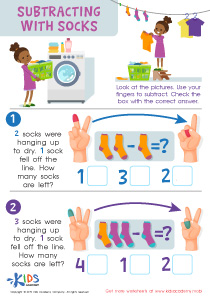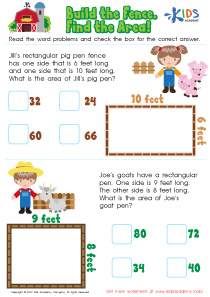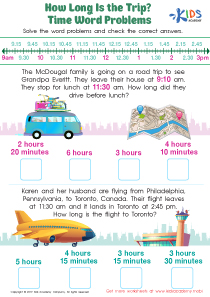Length and Mass Word Problems Worksheets for Ages 3-5
1 filtered results
-
From - To
Introducing our captivating Length and Mass Word Problems worksheets, exclusively crafted for children aged 3-5 years. These educational homework sheets are designed to blend fun with learning, offering young minds an early grasp of basic measurement concepts. Through engaging problems and colorful illustrations, children will explore and compare different lengths and masses, developing critical thinking and problem-solving skills. Perfect for at-home enrichment or preschool classroom activities, these worksheets are engineered to spark curiosity and foster a love for learning. Equip your child with foundational math skills that set the stage for future academic success!


Length Word Problems Worksheet
The Importance of School Worksheets on Length and Mass Word Problems for Young Children
In the formative years of a child's education, the development of basic mathematical skills is crucial. Particularly for children aged 3 to 5, engaging with concepts through practical and relatable problems can be both enlightening and entertaining. School worksheets focused on length and mass word problems serve as an excellent tool for introducing these foundational mathematics concepts in a fun and accessible manner.
Enhanced Understanding of Everyday Concepts
For young learners, understanding abstract concepts can be challenging. Length and mass are everywhere in their environment, from the pencils they use to the snacks they enjoy. School worksheets that incorporate word problems about length and mass help children make connections between their real-world observations and mathematical principles. By using common objects and scenarios, such as measuring the length of a book or weighing a basket of apples, these worksheets make learning relevant and relatable.
Building Problem-Solving Skills
Problem-solving is a critical skill that goes beyond mathematics. School worksheets that challenge children with length and mass word problems encourage them to think analytically and creatively. By figuring out how long a bed is compared to their toy, or how heavy their pet is compared to a set of building blocks, children learn to approach problems methodically, developing both cognitive and decision-making skills. These are essential skills that they will use throughout their educational journey and beyond.
Developing Mathematical Language and Vocabulary
The incorporation of word problems in school worksheets offers children the opportunity to develop mathematical language and vocabulary at an early age. Terms like "longer," "shorter," "heavier," and "lighter" are introduced in context, making it easier for young learners to grasp and remember them. This early exposure helps in laying a strong foundation for more complex mathematical concepts that they will encounter in higher grades.
Encouraging Independent Learning
School worksheets designed for young children are usually crafted to be visually appealing and engaging. They often include colorful graphics and are structured in a way that young learners can work on them with minimal adult supervision. This fosters a sense of independence as children navigate through the problems, make choices, and check their own work. Such activities are invaluable in building confidence and self-reliance in young students.
A Tool for Assessment
For educators and parents, school worksheets on length and mass word problems are an effective tool for assessing a child’s progress and understanding of the concepts. Observing how a child solves these problems can provide insights into their thinking process and highlight areas where they might need additional support or enrichment. This ongoing evaluation is crucial in early childhood education, as it helps tailor educational approaches to meet the individual needs of each student.
Promoting Collaborative Learning
Although designed for individual work, school worksheets can also facilitate collaborative learning experiences. Children can work in pairs or small groups to solve length and mass word problems, discussing their strategies and reasoning. This interaction not only enhances social skills but also allows them to learn from each other. The collaborative environment helps children articulate their thoughts and questions more clearly, deepening their understanding and reinforcing their learning.
Ease of Integration into Daily Routines
School worksheets on length and mass are also beneficial because they can be easily integrated into daily routines. Whether in a classroom setting or at home, these worksheets can be used as a part of everyday lessons or as supplemental activities to reinforce learning. They are also portable and flexible, making them a convenient tool for moments outside the traditional classroom environment, such as during travel or waiting times.
Customization for Diverse Learning Needs
One of the great advantages of school worksheets is their adaptability to cater to diverse learning styles and paces. Worksheets can be customized to include more visuals for visual learners or can be structured in a more interactive way for kinesthetic learners who benefit from a hands-on approach. Additionally, the difficulty level of the problems can be adjusted to suit the learning curve of different children, making these tools incredibly versatile.
Conclusion
In conclusion, school worksheets on length and mass word problems are not only a practical educational resource for children aged 3 to 5 but also a critical developmental tool. They help young learners build fundamental math skills, enhance problem-solving abilities, and encourage a positive attitude towards learning. These worksheets lay down the basic blocks of mathematical thinking and reasoning, preparing children for more advanced concepts in the future. By incorporating such engaging and educational materials into early childhood education, we can ensure that children are not only learning effectively but are also enjoying the process of discovery and learning.
 Assign to My Students
Assign to My Students








